|
Salvatore Randazzio and Pacy Hill had very little in common in their lives, except the ending of them -- in Auburn prison's electric chair 10 days apart during the spring of 1909, each having been convicted in Cattaraugus County of killing his own cousin.
Pacy and Salvatore literally came from different sides of the tracks. Salvatore, 22, was an immigrant laborer working as a member of a railroad section crew. Pacy, 41, was a widower, the last of his branch in a well-respected family line.
Salvatore worked on the West Salamanca railroad section and would sleep in a track siding boxcar fitted with bed booths for section crew members. Pacy lived with relatives (the Hancocks, another part of the family tree) near Cuba, NY, on the border of Cattaraugus and Allegany counties. Apparently what he did mostly was drink.
Salvatore had a cousin, Pietro, who shared the Randazzio family name, who worked with Sal as a member of the track section crew and who also slept in the same boxcar. But Pietro didn't intend to do that all his life. He had saved up the magnificent sum of $45 toward buying passage back to his native Sicily
Family name, blood relation, co-worker comradery -- none of these considerations counted as much as Salvatore's desire to take Pietro's $45. With an accomplice, Salvatore attacked Pietre in his boxcar bunk. The victim was axed, beaten with a metal stove implement, wrapped in his bloody blanket, and thrown in the nearby Allegany River. Somehow the accomplice beat the rap, but not Salvatore.
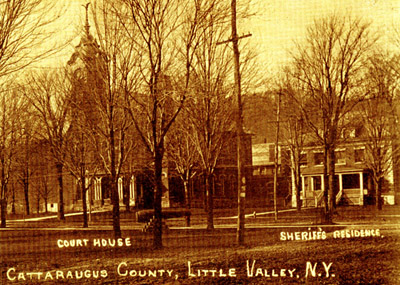 | | Above is a cropped and sepia-tinted image based on a photo postcard dated 8/19/1909 showing the Little Valley court-house, where Salvatore Randazzio and Pacy Hill were tried for their separate crimes, and the 1904-built residence for Cattaraugus County sheriffs. Click the image to access the web site of the Cattaraugus County Historical Museum and Library that made the postcard available to help the New York Correctional History Society with this project.
|
|
With Pacy, respect accorded one's status in the family appeared the consideration that counted most, at least in his drink-disordered thought process.
His booze-boogled brain seemed to draw a distinction between outsiders talking about his tippling and what family members might say, especially younger generation members.
His juniors were still supposed to show the proper respect due him as their senior.
So on March 18, 1908, when his 18-year-old cousin Chloe Hancock scolded him for being drunk, he became enraged at her impenitence and shot her with a revolver.
Her brother, who may have taken some part in the chiding, saw Pacy mortally wound her. Chloe died three days latter.
Denied in the county jail at Little Valley and on death row at Auburn prison the comforting cocoon of alcoholic stupor, the heart-piercing reality of what he had done must have come crashing down upon Pacy. He made an anguished plea to the family for forgiveness, which the Hancock family did convey to him, according to the New York Times April 27th, 1909, report of his execution on the morning of April 26.
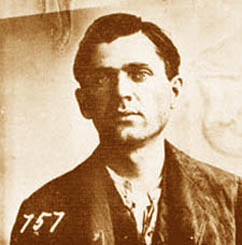
Leon Czolgosz & his execution reenacted.
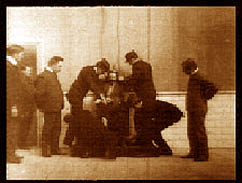 | | Auburn Prison Chaplain Cordello Herrick, who visited Pacy Hill on death row and prayed with him at the execution April 26, 1909, also had been present at the Oct. 29, 1901 electrocution of the convicted assassin of President William McKinley, Leon Czolgosz (mug shot #757 above).
Chaplain Herrick had offered his services to Czolgosz but they were declined by the anarchist more intent in proclaiming the righteousness of his deadly deed. While being strapped into the chair (reenacted without dialog in a scene shown above from a 1901 Thomas Edison silent film), Czolgosz declared: the president . . . was an enemy . . . of the working people. I am not sorry . . . .
More receptive to Rev. Herrick's offer was Chester Gillette (photo below) executed March 30, 1908 for the July 11, 1906 drowning of his pregnant girlfriend in Big Moose Lake.
At about 5 o'clock the morning of his execution, set for 6 a.m. March 30, 1908, Chester Gillette was asked by one of his guards if he wanted breakfast. Gillette at first declined. "You better take something," Chaplain Herrick advised. "Take some coffee and a little something to eat." Chester replied, "All right," and took some nourishment to get through the next hour, his last.
After Gillette's execution, Chaplain Herrick and the Rev. Henry McIlravy issued a joint statement: "Because our relationship with Chester Gillette was privileged, we do not deem it wise to make a detailed statement, and simply wish to say no legal mistake was made in his electrocution."
Chaplain Herrick arguably may be a figure in the illustration (also below) that accompanied a newspaper account of the Gillette execution. Theodore Dreiser's fictionalization, An
American Tragedy, took great liberties with the original facts to turn the story into a critique of U.S society from a socialist class-clash perspective. |
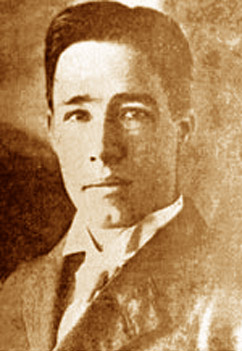
Chester Gillette & his execution sketched.
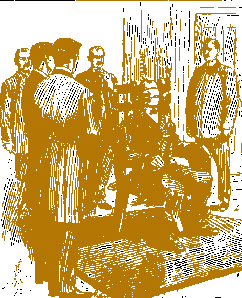 |
|
Nevertheless, that report noted he spent much of his last night writing "a long letter to Mrs. Hancock."
What does a murderer, who behaves as a respectable person when sober, write the mother of his vivacious 18-year-old cousin whom he killed in a alcoholic rage over being scolded for his drinking too much, a murder witnessed by the girl's horrified brother.
What would Pacy have written to the mother had he known then, on the eve of his execution, that in 2 years and 8 months time Chloe's despondent brother, Charles Hancock, would fire a Winchester rifle bullet into his own head?
The death of Charles Hancock, about 28, driver for the Olean Transfer Company, was reported as a suicide by the Watertown Herald Dec 2, 1911. The Winchester was found under his body by fellow tenants in the Olean house where he had his room. They had heard the 38-55 rifle shot and hurried to him. His life lingered only a few minutes.
"Despondency is given as the cause for suicide," the newspaper reported. Without saying his sister's death was a factor in that "despondency," the newspaper story's next sentence noted he was "a brother of Chloe Hancock, shot and killed a few years ago by her cousin, Pacy Hill, afterward electrocuted for the crime."
The morning after writing his "long letter to Mrs. Hancock," Pacy "went to the chair calmly." The state's highest court had rejected his appeal and Gov. Charles Evans Hughes (future Chief Justice of the United States) refused to interfere with the death sentence being carried out.
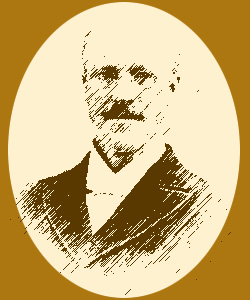 | | Auburn Chaplain Cordello Herrick. Click image for more about him. |
|
Auburn Prison Chaplain Cordello Herrick was quoted by the Times as saying the condemned man was reconciled to his fate. The newspaper noted that the 6:30 electrocution involved "only two shocks . . . the total time of the two was a scant minute."
WEBMASTER NOTES:
-- The Rev. Cordello C. Herrick, who sought to provide spiritual support to death row inmate Pacy Hill in 1909, had succeeded the Rev. Horatio H. Yates as Auburn Prison chaplain in 1897.
The Rev. Yates, who had been chaplain there from December, 1888, attended the world's first execution by electricity Aug.6, 1890.
In addition to the executions of Pacy Hill, Leon Cozlcosz, and Charles Gillette, NYCHS web research identifies a fourth case in which Rev. Herrick's death row role received some newspaper ink.
Whereas the New York Times was the source of the other three execution reports mentioning Chaplain Herrick, the Rochester Union & Advertiser was the source of the fourth report (Wed., Aug. 2, 1899).
Rev. Herrick prayed with Oscar E. Rice as the condemned man, his face ashen, was brought into the death chamber escorted by two prison keepers.
Rice had been convicted of murdering his estranged wife on March 25, 1898, in Westfield, Chautauqua County.
Executed the same day was John Kennedy, convicted of murder in an Erie County murder case unconnected to the Rice case.
It was the first of three occasions when two death row inmates were executed on the same day at Auburn Prison.
-- Pacy Hill was one of the five condemned men in the separate death house at Auburn Prison who were removed temporarily in late March 1909 to the former death row cells in the main building so that Mrs. Mary Farmer, sentenced to be electrocuted March 29, 1909, would be the only inmate occupant in the death house at that time.
She was allowed a one-hour no-contact visit with her husband, James.
Convicted with her in the killing of a Jefferson County neighbor Sarah Brennan, James D. Farmer was, like Pacy Hill, one of the five condemned male inmates moved out of the death house before Mrs. Farmer arrived.
James was brought back for the visit with his wife and then returned to his temporary death row cell in the main building.
A written and notarized statement by her before her execution that he had no hand in the murder of Mrs. Brennan helped win him a new trial at which he was acquitted.
Mrs. Farmer was the first woman executed in the electric chair at Auburn Prison, and the only the second so executed in the state.
The Rev. John J. Hickey, Auburn Prison Catholic chaplain, pastor of Holy Family Church in Auburn, and Mrs. Farmer's spiritual advisor, said the woman's mental condition was such that she should not have been executed.
Thomas McCarthy,
General Secretary/webmaster
NY Correction History Society
|

